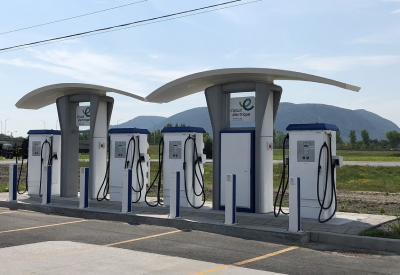The Electric Circuit Celebrates its 10th Anniversary in Quebec

March 31, 2022
The Electric Circuit, Québec’s largest public charging network for electric vehicles, celebrates the 10th anniversary of the commissioning of its first charging stations. This anniversary comes at a time of intense interest in electric vehicles with exponential growth of the number of EVs on our roads. However, when the Electric Circuit was launched a decade ago, this level of interest was not present. The Electric Circuit was the first to make it possible for Québec’s electric vehicle users to adopt this type of vehicle, which is slowly replacing combustion-engine vehicles.
The Electric Circuit’s four founding partners, Les Rôtisseries St-Hubert, RONA, Metro, and the Agence métropolitaine de transport (now exo), backed the deployment of nearly 100 charging stations during the launch year, when there were about 600 electric vehicles on Québec roads. Today, the Electric Circuit is a vast network stretching across Québec and into eastern Ontario, with more than 3,500 charging stations, including more than 620 fast-charge stations, and serving just over 130,000 electric vehicles.
In recent years, the Electric Circuit has been a major player in contributing to the development of Québec’s electric transportation ecosystem. An example of this is AddÉnergie, a network operator based in the city of Québec. The company manufactures charging stations assembled in Shawinigan, and its growth goes hand in hand with the massive deployment of its charging stations within the Electric Circuit. AddÉnergie has become a major industry player, with business now spreading into the United States.

Mogile Technologies, a Pointe-Claire company whose information-sharing platform enables roaming between charging station networks, including between the Electric Circuit and ChargePoint, is another such example. Finally, Hydro-Québec subsidiary AXSO created software that enables advanced management of the Electric Circuit’s network of stations. This software also forms the core of the Electric Circuit app, which makes optimal use of data and artificial intelligence to improve electric vehicle users’ experience, notably with its trip planner.
In a context of rapidly increasing adoption of electric vehicles, the Electric Circuit leadership role is more significant than ever, and it is continuing the massive deployment of charging infrastructure, including:
- deployment of 2,500 new fast-charge stations by 2030
- a funding program for 4,500 curbside charging stations to facilitate charging in major urban centres
- deployment of stations with a power level greater than 120 kW
- exploration of new market segments, such as heavy vehicle charging
- ongoing efforts regarding implementing tangible solutions to meet the needs of electric vehicle users without a garage or private parking, and no easy access to home charging
- close monitoring of technological developments through test beds for new ultra-fast charging technologies, induction charging, and even solar-powered stand-alone stations.
For more information: https://lecircuitelectrique.com/en/about/















